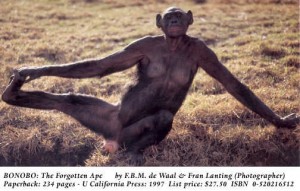Are Bigfoot Human? Controversial Morris Goodman Has Died
Posted by: Loren Coleman on November 19th, 2010

Are Bigfoot/Sasquatch humans? Hominids? Hominoids? In my Bigfoot!: The True Story of Apes in America, (NY: Paraview Pocket-Simon and Schuster, 2003), the second most popular chapter is the final one. (Yes, the chapter “Sex and the Single Sasquatch” still gets the most comment.) In the last chapter, I look at whether Bigfoot is an ape or a human. Of course, the lines have become confused in recent years. Humans are naked apes and all that.

An authority making an appearance in that chapter of mine is biologist Morris Goodman, who several years ago came up with a controversial proposal that chimpanzees and bonobos be reclassified from the genus Pan into the genus Homo.

In 1962, Dr. Goodman’s assertion that chimpanzees and gorillas are genetically more closely related to humans than to other apes, and thus should be placed in family Hominidae rather than Pongidae, sparked debate. However, his research based on molecular evidence has since been generally accepted, including a later discovery from DNA sequences that chimpanzees and humans are more closely related to each other than either is to gorillas or other apes.
Now, the esteemed evolutionary biologist and anthropologist Morris Goodman has passed away. Morris Goodman, Ph.D., distinguished professor of Anatomy and Cell Biology, and a member of the Wayne State University School of Medicine, died November 14, 2010. He was 85.
Born in Milwaukee, Wisconsin, on January 12, 1925, Goodman attended the University of Wisconsin, Madison, before enlisting in the United States Air Force in 1943. Returning to Wisconsin, he earned his bachelor’s, master’s, and doctoral degrees in zoology. After a series of postdoctoral appointments, in 1958 he took a position at Wayne State University, where he remained for fifty-two years. In the late 1950s, he became interested in evolution, and swiftly became a pioneer in molecular systematics, especially as applied to primates.
Goodman was a Distinguished Professor at the Center for Molecular Medicine and Genetics at Wayne State University School of Medicine, editor-in-chief of the journal Molecular Phylogenetics and Evolution, and a member of the anthropology section of the United States National Academy of Sciences.
His honors included election to the American Academy of Arts and Sciences and the National Academy of Sciences and in 2002, Dr. Goodman received the Charles R. Darwin Award for Lifetime Achievement from the American Association of Physical Anthropologists.
About Loren Coleman
Loren Coleman is one of the world’s leading cryptozoologists, some say “the” leading living cryptozoologist. Certainly, he is acknowledged as the current living American researcher and writer who has most popularized cryptozoology in the late 20th and early 21st centuries.
Starting his fieldwork and investigations in 1960, after traveling and trekking extensively in pursuit of cryptozoological mysteries, Coleman began writing to share his experiences in 1969. An honorary member of Ivan T. Sanderson’s Society for the Investigation of the Unexplained in the 1970s, Coleman has been bestowed with similar honorary memberships of the North Idaho College Cryptozoology Club in 1983, and in subsequent years, that of the British Columbia Scientific Cryptozoology Club, CryptoSafari International, and other international organizations. He was also a Life Member and Benefactor of the International Society of Cryptozoology (now-defunct).
Loren Coleman’s daily blog, as a member of the Cryptomundo Team, served as an ongoing avenue of communication for the ever-growing body of cryptozoo news from 2005 through 2013. He returned as an infrequent contributor beginning Halloween week of 2015.
Coleman is the founder in 2003, and current director of the International Cryptozoology Museum in Portland, Maine.










My condolences to the family and friends of Dr. Goodman. He was a true pioneer in his field and sought to extend his reach into cryptozoology to shows us that perhaps once found , we will see Bigfoot is indeeed more closely related to us as Enkidu was to Gilgamesh. The photo of the bonobo serves to illustrate almost beyond a doubt this convention. Let’s wait and see!
Sad news.
Interesting that you include in this story a photo of a bonobo, but offer no further comment upon them in the story. I think by now we’re all familiar with the news of the close relationship between humans and chimpanzees. But I’ve never seen any study as to our relationship with bonobos. Are bonobos even more closely to us than chimps? Less closely? The same?
“Interesting that you include in this story a photo of a bonobo, but offer no further comment upon them in the story.”
Ah, more evidence that things can hide in plain sight right before observers. Bonobos are mentioned in the paragraph/sentence directly under that image of a bonobo.
Dr. Goodman is a true pioneer and one that will be missed. It will take a specimen to prove him correct either living or dead and that’s what we all are looking for. Condolences to his family, friends and those who respect his work. My best.
Apologies. You are of course correct, Loren, that the word “bonobo” appears in the paragraph below the photo in your mention of Dr. Goodman’s proposal that chimpanzees and bonobos be reclassified from genus Pan to genus Homo.
What I have been wondering about is whether there are any studies comparing the DNA sequences of chimpanzees and bonobos vis a vis their comparative relationship to humans.
I know that some DNA analysis was involved in the decision to cease classifying bonobos as a subspecies of chimpanzees, and to reclassify them as a separate species. But I never saw or heard any discussion as to how (or whether) that analysis made any determination as to whether bonobos were actually more (or less) closely related to humans than chimpanzees.